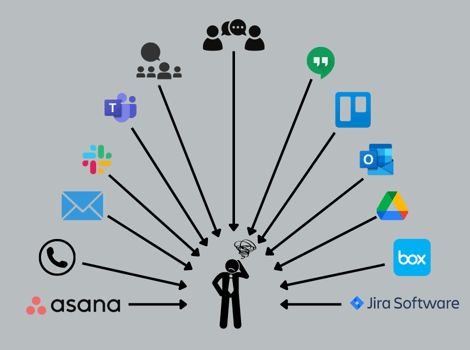A Brief on the Creative Brief
Paul Legan, June 23, 2022
A client has a request. An internal department has come up with their next big idea. The product team has a launch coming. These are a few of the many situations that result in a request to a creative team. And, when 3|SHARE asked about the biggest pain points in the creative process, we learned that even before a project even begins, this is where they start.
Depending on the organization, the process varies but most creative work starts with the submittal of a creative brief or less formal request format. This sounds simple but we found out that what should be the easiest part of the process has become difficult. Why?
As mentioned in our Top Creative Issues article, only 61% of teams surveyed have a process. The good news is that when a process exists, 88% of the time a tool exists to manage the process. This sounded promising until we dug in a bit further. It turns out that 70% of the time, when there is a tool in place, it is not the only way requests come into the creative team! Requests seem to come from everywhere making them hard to track, hard to analyze and hard to turn into a project.
How do requests come in? Survey respondents gave us a list!

- Messaging apps (Microsoft Teams, Slack, Google Chat)
- Trello
- Google Drive
- JIRA
- Asana
- Box
- Phone calls
- Meetings
- Other informal verbal interactions
This means that the information received by teams is inconsistent and the problem of “lack of clarity around requests” isn’t a small one.
If this sounds like your organization, don’t worry. You can fix this. The solution will seem involved at first but once you create a process people can start following, and enforce the process, work will get started more easily and everyone will benefit.
What should you do?
- Identify the types of requests you receive and the information you need to complete work related to those requests.
- Determine how you want to receive requests. We recommend centralizing this to one tool. Adobe Workfront is a great holistic solution to manage your creative process and we’ll talk more about that below. Otherwise, Google and Microsoft offer forms if your team uses their platforms. If you use a took like Jira to manage work, a form with a Zapier integration can be used to create a ticket in the system directly. If you need to go with email, providing a template to your organization can improve the information you receive.
- Educate the team. Let requestors know you have a new process, inform them of the benefits of following the process and when people do not follow the process, respond to their rogue request with kindness. Remind them of the new process and ask them to submit their request via the process.
We mentioned Adobe Workfront above. In our experience, you may need to use complex form logic or multiple forms to address all request types. In Workfront, one or more forms can be created which require all the information needed in order for the creative team to receive a complete request. The team can determine the forms’ text and logic and implement it themselves. Enquiries about the request can be made via Workfront so all interactions and updates are in one place. In addition to request intake, Workfront can manage the entire workflow through project creation, approvals and finally delivery.
Basically, Workfront will provide the mechanism for anyone who needs to easily make a request and then to the team as they complete the work. Once a request is made, it can be assessed and turned into a project with resources assigned or can be placed on a backlog. Either way, everything is in one system. Since resource management can also take place in Workfront, tasks can be prioritized for teams reducing friction around what team members should work on next.
This video is a walkthrough of how Workfront custom forms can be used to intake creative requests and manage approval workflows.
3|SHARE can assist your team with cleaning up the creative process. Contact us to learn more about our assessments as well as how our expertise in Workfront and Adobe Experience Cloud can benefit your team.
Video Transcript
Paul Legan: [00:04:13] My name is Paul Legan, and I am the Chief Technology Officer at 3|SHARE, a Platinum Adobe implementation partner for Experience Cloud related products. So, over the years, 3|SHARE has advised on and deployed hundreds of digital asset management systems for clients, built on top of AEM assets. Many of these clients look to us for our expertise in content automation.
And many of these automation and production projects start off as AEM assets implementations, but quickly grow to include a more robust tool like Adobe Workfront to manage all aspects of the creative process. Perhaps the most common starting point for workflow and project execution within Workfront is some sort of creative brief which I'm going to talk a little bit about today.
Now a creative brief typically takes the form of a PDF. Something like we're seeing now. And the idea of it is it captures information about a project prior to start [00:05:13] that allows the project to be approved and then ultimately delivered. And so for most teams, even smaller ones, this PDF starts to become cumbersome when you pass it around to colleagues to gain the approvals you need to start at work. And then, once you're done with a project, how do you manage all the information that you learned during the project? Or, you know, spend budgeting, all that stuff. How do you tie that back to the original brief?
As that process gets more cumbersome. Obviously you want to replace it with a tool like Workfront. And what we typically advise is before you try and do away with everything, you really need to ask yourself two questions: "What types of requests do you receive as an organization?" And, "How would you like to receive these types of requests?" And within Workfront, it's very easy to map those two questions to actual pieces of functionality within the tool.
So custom forms within Workfront is really the "what". So what information am I trying to capture? [00:06:13] What information do I want my colleagues to know about preapproval? And then post-launch of a particular project all that information is cap typically captured in a custom form. Now the, "how" is typically the process behind it, the approval process, the review process.
So within Workfront, you can create reusable approval processes. So again, this controls the how information and projects ultimately are executed.
An actual custom form is a series of fields that you can add that have labels that have different field types. All of this information can be modeled within a form here via drag and drop.
And this form can be reused anywhere within Workfront. Same is true of the approval process. Creating these approvals, these flows, they can ultimately be assigned to each project that you create within Workfront. However, it gets a little bit bothersome to manually attach these forms and processes to each [00:07:13] project that you create.
So, we often create a series of templates and templates within Workfront allow you to automatically assign approvals and custom forms, uh, to each project that's created based on this template. So here I've created a 3|SHARE template. It automatically includes the custom form that I've created. It can automatically be associated with different programs or organizations or departments within your broader company.
And it can help you facilitate conversation across all the different projects that you create based upon it. So if I were to come over to my implementation program and create a new project, I can see that there is a new project from template option. I select my template and once I've entered some basic information, I now have a project. That automatically has an approval assigned. [00:08:13]Automatically has the custom four fields that I've created. And, it allows you to prepopulate really anything that you need. And so from there, you and your colleagues are well on your way to actually delivering the work without a tool or process getting in your way.
Topics: Digital Marketing, Creative Process

